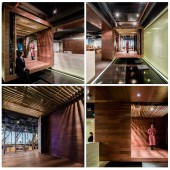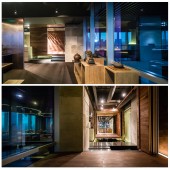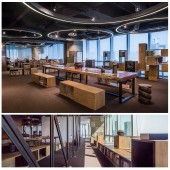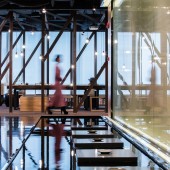
| THE AWARD |
| CATEGORIES |
| REGISTRATION |
| SUBMIT YOUR WORK |
| ENTRY INSTRUCTIONS |
| TERMS & CONDITIONS |
| PUBLICATIONS |
| DATES & FEES |
| METHODOLOGY |
| CONTACT |
| WINNERS |
| PRESS ROOM |
| GET INVOLVED |
| DESIGN PRIZE |
| DESIGN STORE |
| THE AWARD | JURY | CATEGORIES | REGISTRATION | PRESS | WINNERS | PUBLICATIONS | ENTRY INSTRUCTIONS |
Seven Chakras Multifunctional Experience Pavilion by Shen Qiang |
Home > Winners > Design #33701 >Interview |
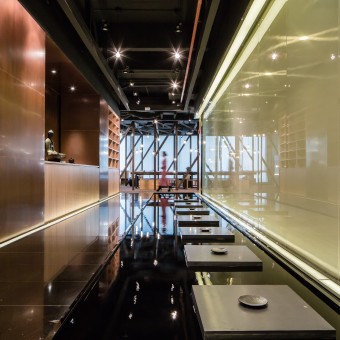 |
|
FS: What is the main principle, idea and inspiration behind your design?
QS: Seven Chakras(Base Chakra, Navel Chakra, Heart Chakra, Throat Chakra, Third Eye Chakra, Crown Chakra, Brahma Chakra). It seems like a meditating person in the space plane, and the seven pillars in this plane just accord with the seven chakras of human body.
FS: What has been your main focus in designing this work? Especially what did you want to achieve?
QS: The plane is planed according to the seven chakras. Base Chakra, Navel Chakra and Heart Chakra called the Desire Realm. In the area, where the three pillars locate, planed as teahouses or exhibition just about tea. So it could be called” the Enlightenment with Tea”. Throat Chakra, Third Eye Chakra and Crown Chakra called the Form Realm. And in this area, where the three pillars locate, planed as meditation section. Brahma Chakra called Supreme Realm. And the area, where the relevant pillar located, planed as” Meditation”. There are seven sentences in the first paragraph of the “Peripatetic Journey”, which was written by ancient Chinese ideologist, Zhuangzi, are also discuss about the change of human body, when people fall into the meditation. The seven sentences are in line with the seven chakras of human body and the seven pillars of the plane.
FS: What are your future plans for this award winning design?
QS: Carry forward the Chinese culture
FS: How long did it take you to design this particular concept?
QS: Three Months
FS: Why did you design this particular concept? Was this design commissioned or did you decide to pursuit an inspiration?
QS: It seems like a meditating person in the space plane, and the seven pillars in this plane just accord with the seven chakras of human body.
FS: Is your design being produced or used by another company, or do you plan to sell or lease the production rights or do you intent to produce your work yourself?
QS: yes
FS: What made you design this particular type of work?
QS: Meditation&zen
FS: Where there any other designs and/or designers that helped the influence the design of your work?
QS: ancient Chinese ideologist, Zhuangzi
FS: Who is the target customer for his design?
QS: Interested in Chinese culture
FS: What sets this design apart from other similar or resembling concepts?
QS: Chinese culture and Seven Chakras
FS: How did you come up with the name for this design? What does it mean?
QS: Seven Chakras(Base Chakra, Navel Chakra, Heart Chakra, Throat Chakra, Third Eye Chakra, Crown Chakra, Brahma Chakra). It seems like a meditating person in the space plane, and the seven pillars in this plane just accord with the seven chakras of human body. The plane is planed according to the seven chakras. Base Chakra, Navel Chakra and Heart Chakra called the Desire Realm. In the area, where the three pillars locate, planed as teahouses or exhibition just about tea. So it could be called” the Enlightenment with Tea”. Throat Chakra, Third Eye Chakra and Crown Chakra called the Form Realm. And in this area, where the three pillars locate, planed as meditation section. Brahma Chakra called Supreme Realm. And the area, where the relevant pillar located, planed as” Meditation”. There are seven sentences in the first paragraph of the “Peripatetic Journey”, which was written by ancient Chinese ideologist, Zhuangzi, are also discuss about the change of human body, when people fall into the meditation. The seven sentences are in line with the seven chakras of human body and the seven pillars of the plane.
FS: What is the most unique aspect of your design?
QS: Moving Space.he biggest box located above the pool, and it is controlled by iPad, different locations have different functions. When it by sliding along the pool reach at the meditation room, it could fuse together with the meditation room and become a secret entrance of the meditation room. When the folding doors are opened, it could connect with the meditation and turn into a larger space. When the box slide continued forward, it could turn into the entrance of the waiting room. Sliding forward again, when it parallel to front desk, and it could turn into a stage or rostrum. Go on sliding forward, when it reach at the middle area, it could turn into a seven-stringed zither concert room. Keeping on sliding forward, it could turn into music alcove, bar, VIP room and so on. In one word, it has many potential. Also the whole space could free combine or separate according to the different functions.
FS: Who did you collaborate with for this design? Did you work with people with technical / specialized skills?
QS: Feng Cheng cheng
FS: What is the role of technology in this particular design?
QS: technology with traditional technology
FS: Is your design influenced by data or analytical research in any way? What kind of research did you conduct for making this design?
QS: “Peripatetic Journey” written by ideologist, Zhuangzi
FS: What are some of the challenges you faced during the design/realization of your concept?
QS: The variety of the space,Moving Space
FS: What did you learn or how did you improve yourself during the designing of this work?
QS: Any time you should stick to your own ideas and try all means to achieve
FS: Any other things you would like to cover that have not been covered in these questions?
QS: no
FS: Thank you for providing us with this opportunity to interview you.
A' Design Award and Competitions grants rights to press members and bloggers to use parts of this interview. This interview is provided as it is; DesignPRWire and A' Design Award and Competitions cannot be held responsible for the answers given by participating designers.
| SOCIAL |
| + Add to Likes / Favorites | Send to My Email | Comment | View Press-Release |

